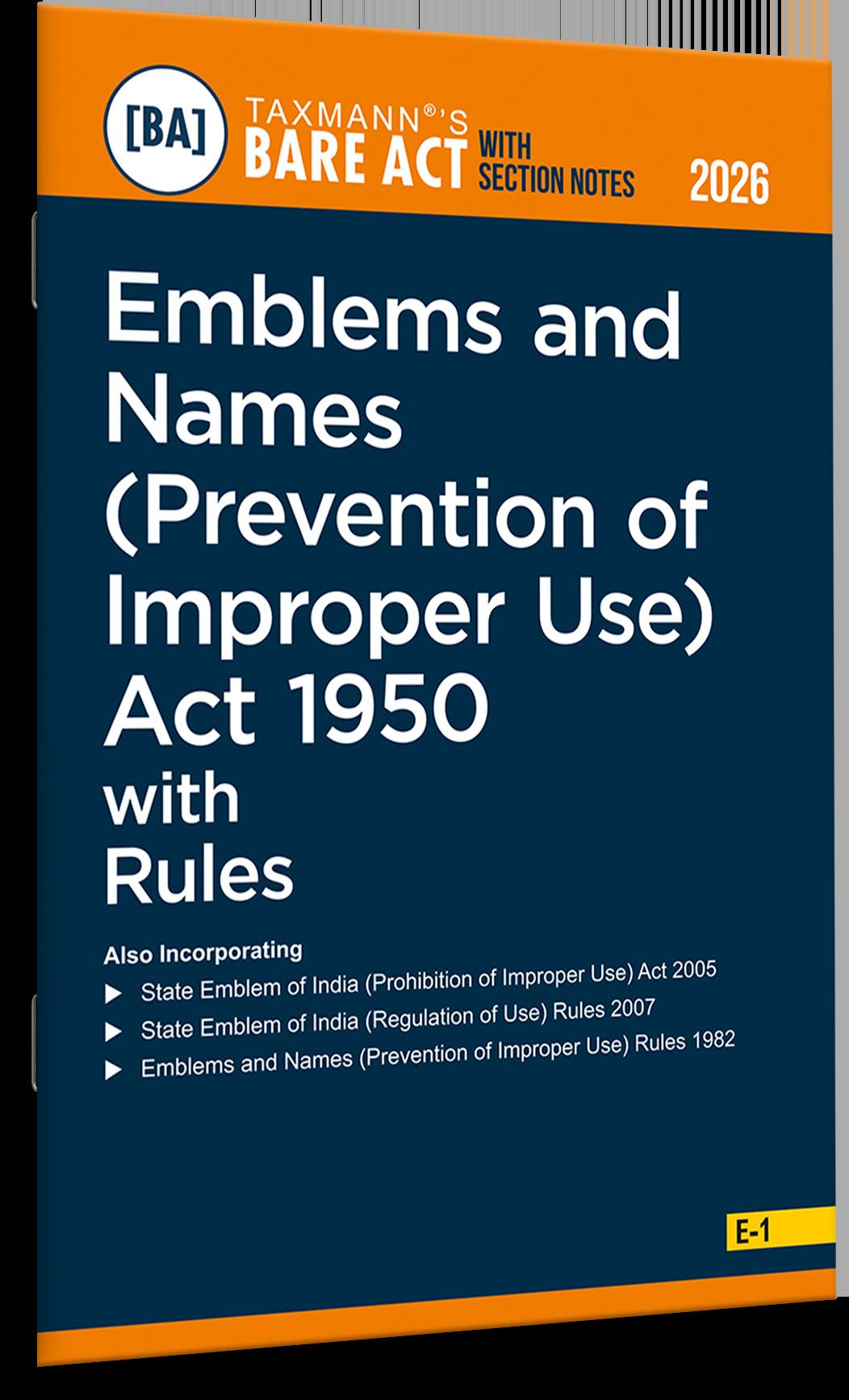© Taxmann Price : ` 95
Law stated in this book is as updated till 1st November, 2025
Published by : Taxmann Publications (P.) Ltd.
Sales & Marketing : 59/32, New Rohtak Road, New Delhi-110 005 India
Phone : +91-11-45562222
Website : www.taxmann.com
E-mail : sales@taxmann.com
Regd. Office : 21/35, West Punjabi Bagh, New Delhi-110 026 India
Printed at :
Tan Prints (India) Pvt. Ltd.
44 Km. Mile Stone, National Highway, Rohtak Road Village Rohad, Distt. Jhajjar (Haryana) India
E-mail : sales@tanprints.com
Disclaimer
Every effort has been made to avoid errors or omissions in this publication. In spite of this, errors may creep in. Any mistake, error or discrepancy noted may be brought to our notice which shall be taken care of in the next edition. It is notified that neither the publisher nor the author or seller will be responsible for any damage or loss of action to any one, of any kind, in any manner, therefrom. It is suggested that to avoid any doubt the reader should cross-check all the facts, law and contents of the publication with original Government publication or notifications.
No part of this book may be reproduced or copied in any form or by any means [graphic, electronic or mechanical, including photocopying, recording, taping, or information retrieval systems] or reproduced on any disc, tape, perforated media or other information storage device, etc., without the written permission of the publishers. Breach of this condition is liable for legal action.
For binding mistake, misprints or for missing pages, etc., the publisher’s liability is limited to replacement within seven days of purchase by similar edition. All expenses in this connection are to be borne by the purchaser. All disputes are subject to Delhi jurisdiction only.
EMBLEMS AND NAMES (PREVENTION
STATE EMBLEM OF INDIA (PROHIBITION OF IMPROPER USE) ACT, 2005
1.
STATE EMBLEM OF INDIA (REGULATION OF USE) RULES, 2007
or Statutory Authorities, Ministries or Departments of the Central Government, State Governments or Union Territory Administrations and Other Government Functionaries which
EMBLEMS AND NAMES (PREVENTION OF IMPROPER USE) RULES, 1982
3. Appointment of designated officer 30
4. Appointment of Committee 30
5. Co-option of Members of the Committee 31
6. Processing of proposals 31
7. Recommendation of the Committee. 31
8. Use of emblems and names contained in the Schedule 31
Emblems and Names (Prevention of Improper Use) Act, 1950
[12 OF 1950*]
[AS AMENDED UP TO DATE]
An Act to prevent the improper use of certain emblems and names for professional and commercial purposes.
BE it enacted by Parliament as follows :—
Short title, extent, application and commencement.
1. (1) This Act may be called the Emblems and Names (Prevention of Improper Use) Act, 1950.
(2) It extends to the whole of the India 1[***], and also applies to citizens of India outside India.
(3) It shall come into force on such date2 as the Central Government may, by notication in the Of cial Gazette, appoint.
COMMENTS
SECTION NOTES
Pan-India applicability: This Act extends to the whole of India; No exemption from applicability to J&K.
Extra-territorial application: This Act also applies to citizens of India outside India.
De nitions.
2. In this Act, unless the context otherwise requires,—
(a) “emblem” means any emblem, seal, flag, insignia, coat-of-arms or pictorial representation specified in the Schedule;
(b) “competent authority” means any authority competent under any law for the time being in force to register any company, firm or other body of persons or any trade mark or design or to grant a patent;
*Dated 1-3-1950
1. Words “except the State of Jammu and Kashmir” omitted by the Jammu and Kashmir (Extension of Laws) Act, 1956, w.e.f. 1-11-1956.
2. Enforced with effect from 1-9-1950.
(c) “name” includes any abbreviation of a name. 1
S. 3 EMBLEMS AND NAMES (PREVENTION OF IMPROPER USE) ACT, 1950 2
COMMENTS
CASE LAWS
Definition of ‘Emblem’ under the Act - Geographical name not covered in Schedule – The petitioners sought to prohibit the use of the word “Goa” in the trademark “Goa 1000 Gutka” used in the marketing of gutka and pan masala products, arguing that it implied government endorsement and violated the Act. The Court examined Section 2(a), which defines an “emblem” as including only those listed in the Schedule. Clause 4 of the Schedule specifies the name, emblem, or official seal of the Government of India or any State, or any name suggesting government patronage. The Court held that “Goa,” as a geographical term, is not listed in the Schedule and cannot be equated with the State Government. Therefore, its use in a trademark does not amount to improper use under Section 3 read with Section 2(a). The plea was held to be misconceived and filed after an inordinate delay, and the petition was dismissed with costs — Wyawahare & Sons v. Madhukar Raghunath Bhave AIR 2007 BOMBAY 184.
Prohibition of improper use of certain emblems and names.
3. Notwithstanding anything contained in any law for the time being in force, no person shall, except in such cases and under such conditions as may be prescribed by the Central Government, use, or continue to use, for the purpose of any trade, business, calling or profession, or in the title of any patent, or in any trade mark or design, any name or emblem speci ed in the Schedule or any colourable imitation thereof without the previous permission of the Central Government or such of cer of Government as may be authorised in this behalf by the Central Government.
COMMENTS
SECTION NOTES
Without the previous permission of the Central Government or authorised officer of that Government, no person shall use or continue to use any name or emblem specified in the Schedule or any colourable imitation thereof: for the purpose of any trade, business, calling or profession, or in the title of any patent, or in any trade mark or design.
Prior permission as above is not required in such cases and under such conditions as may be prescribed by the Central Government.
If any question arises before a competent authority whether any emblem is an emblem specified in the Schedule or a colourable imitation thereof, the competent authority may refer the question to the Central Government, and the decision of the Central Government thereon shall be final [Section 4(2)]
Penalty for contravention of this Section: Any person who contravenes the provisions of section 3 shall be punishable with fine which may extend to five hundred rupees. [Section 5]
Previous Sanction for prosecution: No prosecution for any offence punishable under this Act shall be instituted, except with the previous sanction of the Central Government or of any officer authorised in this behalf by general or special order of the Central Government. [Section 6]
3 EMBLEMS AND NAMES (PREVENTION OF IMPROPER USE) ACT, 1950 S. 4
CASE LAWS
Depiction of national flag in Film - The petitioners, practicing advocates, sought a writ to prohibit the exhibition of a Kannada film “Kona Eedaite” alleging it degraded the judiciary and misused the National Flag. A particular scene showed a lawyer, frustrated and disillusioned with corruption and injustice, throwing away his robe and collapsing before the National Flag within the court premises. The petitioners contended this was derogatory and violated Section 3 of the 1950 Act. The Court held that the Emblems and Names (Prevention of Improper Use) Act, 1950 does not prohibit all use of the National Flag, but only its improper use as defined within the statute. The scene, in the Court’s view, symbolically depicted a moment of despair followed by inspiration drawn from the ideals the Flag represents. This use, the Court held, was neither disrespectful nor improper under Section 3. It conveyed a transformative message of justice and national ideals, not an abuse of the emblem. Thus, there was no violation of the Act, and the petition to prohibit the film’s release on this ground was dismissed — N. P. Amrutesh v. State of Karnataka AIR 1995 KARNATAKA 290.
Improper use of police emblem in film promotion - Lack of real emblem or Deceptive Intent - The applicants, a film director and a production company, faced prosecution for allegedly misusing the name and seal of the Mumbai Police Commissioner in promotional invitations for the film “Shootout at Wadala.” These invitations, styled as notices from the Commissioner of Police, summoned media personnel to a fabricated briefing about organized crime, dated 27th February 1981. However, the reverse side of the invitation explicitly stated it was for promotional purposes only. The FIR claimed the emblem of the police had been improperly used. The Court found that the so-called emblem did not resemble any real emblem listed in the Schedule of the 1950 Act. Further, there was no actual misuse of an official emblem nor any intent to deceive. The invitations were clearly promotional and no person of ordinary prudence could have been misled. As such, no offence under Section 3 of the Act was made out, and the FIR and investigation were quashed — Sanjay Gupta v. State of Maharashtra 2013 CRI. L. J. (NOC) 282 (BOM.)
Use of State name in trademark - Government patronage and trademark Misconception -The petitioners sought enforcement of the Emblems and Names (Prevention of Improper Use) Act, 1950 against the use of the word “Goa” in the trademark “Goa 1000 Gutka,” alleging it implied state patronage and tarnished the image of Goa. They prayed for cancellation of the trademark and a restraint on its further use. However, the Court clarified that Section 3 prohibits the use of only those names or emblems specifically mentioned in the Schedule of the Act, which includes names or emblems of the Government of India or a State Government, or any name suggesting their patronage. The name of a geographic place like “Goa” is not included in the Schedule, nor does its use amount to suggesting government patronage. The Court reasoned that “Goa” is a geographical term and not synonymous with the State Government, hence its use in the trademark does not violate Section 3. Consequently, the petition was dismissed as misconceived and an abuse of process — Wyawahare & Sons v. Madhukar Raghunath Bhave AIR 2007 BOMBAY 184.
Prohibition of registration of certain companies, etc.
4. (1) Notwithstanding anything contained in any law for the time being in force, no competent authority shall,—
(a) register any company, firm or other body of persons which bears any name, or
(b) register a trade mark or design which bears any emblem or name, or
S. 5 EMBLEMS AND NAMES (PREVENTION OF IMPROPER USE) ACT, 1950 4
(c) grant a patent in respect of an invention which bears a title containing any emblem or name, the use of such name or emblem is in contravention of section 3.
(2) If any question arises before a competent authority whether any emblem is an emblem speci ed in the Schedule or a colourable imitation thereof, the competent authority may refer the question to the Central Government, and the decision of the Central Government thereon shall be nal.
COMMENTS
SECTION NOTES
The prohibitions imposed by section 4(1) on competent authorities are as follows:
No competent authority shall register any company, firm or other body of persons if the name of the company or firm or body is in contravention of section 3. [Section 4(1) (a)]
No competent authority shall register a trade mark or design which bears any emblem or name, where the use of such name or emblem is in contravention of section 3. [Section 4(1)(b)]
No competent authority shall grant a patent in respect of an invention which bears a title containing any emblem or name, the use of such name or emblem is in contravention of section 3. [Section 4(1)(c)]
Note the following points:
Any question on whether section 3 is contravened or not is to be referred to the Central Government/its authorised officer.
The decision of the Central Government/its authorised officer shall be final on any question as to whether use of name or emblem contravenes section 3.
See sections 5 and 6
Penalty.
5. Any person who contravenes the provisions of section 3 shall be punishable with ne which may extend to ve hundred rupees.
COMMENTS
SECTION NOTES
See also section 4(2) and Section 6
CASE LAWS
Penalty for misuse of emblem - Absence of real emblem or criminal intent – The applicants, a film director and a production company, were accused of using the official seal of the Mumbai Police Commissioner in promotional invitations for the film Shootout at Wadala. These invitations mimicked official communication and announced a fictional public address by the Police Commissioner. Although the FIR alleged misuse of a police emblem, the Court found that the impression on the invitation did not resemble any emblem listed in the Schedule of the 1950 Act. Section 5 provides for punishment only where there is a contravention of Section 3, which was not satisfied in this case. The alleged seal was not a notified emblem, and the document clearly stated it was for
5 EMBLEMS AND NAMES (PREVENTION OF IMPROPER USE) ACT, 1950 S. 9
promotional use only. There was no evidence of intention to deceive or actual harm caused. Hence, the invocation of Section 5 was unjustified, and the FIR along with investigation was quashed — Sanjay Gupta v. State of Maharashtra 2013 CRI. L. J. (NOC) 282 (BOM.) = 2013 (2) ABR 246.
Previous sanction for prosecution.
6. No prosecution for any offence punishable under this Act shall be instituted, except with the previous sanction of the Central Government or of any of cer authorised in this behalf by general or special order of the Central Government.
COMMENTS
SECTION NOTES
Section 6 follows as a natural and logical corollary of section 4(2).
As section 4(2) vests final decision making authority in Central Government to decide whether section 3 is contravened or not, launching a prosecution without Central Government’s prior sanction would be a waste of time if Central Government determines no contravention of section 3 has taken place in the facts and circumstances of the case after the prosecution proceedings have been launched.
Savings.
7. Nothing in this Act shall exempt any person from any suit or other proceeding which might, apart from this Act, be brought against him.
Power of the Central Government to amend the Schedule.
8. The Central Government may, by noti cation in the Of cial Gazette, add to or alter the Schedule, and any such addition or alteration shall have effect as if it had been made by this Act.
Power to make rules.
9. 3[(1)] The Central Government may, by noti cation in the Of cial Gazette, make rules to carry out purposes of this Act.
4[(2) Every rule made under this Act shall be laid, as soon as may be after it is made, before each House of Parliament, while it is in session, for a total period of thirty days which may be comprised in one session or in two or more successive sessions, and if, before the expiry of the session immediately following the session or the successive sessions aforesaid, both Houses agree in making any modi cation in the rule, or both Houses agree that the rule should not be made, the rule shall thereafter have effect only in such modi ed form or be of no effect, as the case may be; so, however, that any such modi cation or annulment shall be without prejudice to the validity of anything previously done under that rule.]
3. Section 9 renumbered as sub-section (1) thereof by the Delegated Provisions (Amendment) Act, 1985, w.e.f. 15-5-1986.
4. Inserted, ibid







